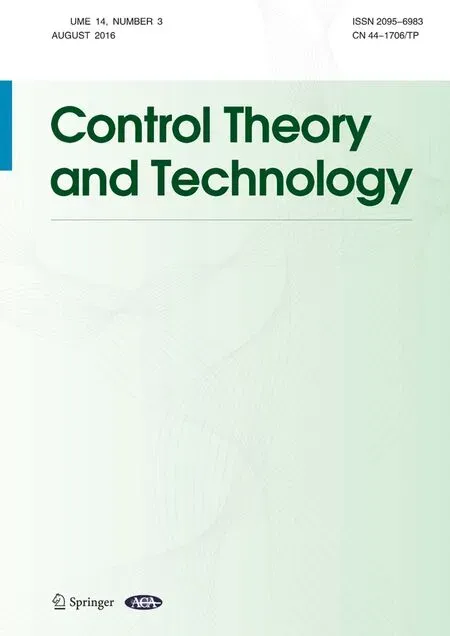Special issue on disturbance rejection:a snapshot,a necessity,and a beginning
2016-03-24
A fundamental responsibility of a scientist is to continue to question how the problems are framed and what presumptions are made.This is particularly true in the field of automatic control,which has been pre-occupied with the study of stability and optimality,premised on the accurate mathematical description of the physical processes.Central to the engineering practice,however,is the problem of internal and external disturbances,as articulated brilliantly by Prof.H.S.Tsien some 60 years ago.The history of automatic control has been,therefore,the history of two distinct conceptualizations:of stability and optimality on the one hand and of disturbance rejection on the other.This special issue in Control Theory and Technology is a timely snapshot of some current work in the latter.With only seven papers,it is obviously a limited sample of the questions being asked and the progress made.Nonetheless,it points to the necessity and urgency of such a study,which has become increasingly active in recent years.
It is shown in the paper“Active disturbance rejection control:between the formulation in time and the understanding in frequency”,by Zheng and Gao,that the machinery of disturbance rejection,which is often given in time domain,can only be truly understood in the frequency domain with a vocabulary that is familiar to engineers.A conceptualization of engineering science is meaningful only if it can be understood by the practitioners.Likewise,the paper“Yet another tutorial of disturbance observer:robust stabilization and recovery of nominal performance”,by Shim et al.,presented an overview and the practical significance of the technique known as the disturbance observer.
In term of the centrality of disturbance rejection in automatic control,the papers in this special issue show how a classical problem of automatic control can be reformulated as a problem of disturbance rejection.In particular,the problem of uncertain lower triangular nonlinear systems with stochastic disturbance is tackled by Wu and Guo in the paper“Extended state observer for uncertain lower triangular nonlinear systems subject to stochastic disturbance”,where a nonlinear extended state observer is constructed and the convergence is analyzed.Moreover,the problem of non-minimum phase system is tackled by Xue et al.in the paper“On ADRC for non-minimum phase systems:canonical form selection and stability conditions”,where the choice of canonical form is examined and the stability conditions are derived.The problem of sector-bounded nonlinearities is tackled by Novara et al.in the paper“Control of systems with sector-bounded nonlinearities:robust stability and command effort minimization by disturbance rejection”.These studies of general problems are instrumental in building a sound theoretical foundation and they are complemented by the studies of practical issues.
The problem of inter-sample behavior is investigated by Tian et al.in the paper“Sampled-data extended state observer for uncertain nonlinear systems”,where a predictor is employed to estimate the output between samples.This helps to improve the performance of disturbance rejection when the sampling rate is limited.The problem of boost dc-dc converter is tackled by Sira-Ramirez et al.using yet another kind of disturbance rejection technique known as flat filtering,in the paper“Robust flat filtering DSP based control of the boost converter”.This shows the versatility in the methods of disturbance rejection and their effectiveness in tackling significant engineering problems.The results are validated in both simulation and experimentation.
In summary,the readers may find in this special issue the necessity and urgency in the study of disturbance rejection,in terms of 1)an alternative framework where new,general purpose,industrial control technologies are being generated and deployed;2)the vast range of applications covering all industry sectors;3)the compelling need for understanding by practitioners who put the new technologies to daily use;and 4)the beginning of a new kind of control theory dictated by the reality of engineering practice.We hope that such study proves to be exciting for everyone,whether you are a student new to automatic control,a seasoned practitioner tired of the endless PID tuning,an innovator looking to break the stagnation in control technologies,or a theoretician looking for meaningful problems and impactful solutions.
Finally,the guest editor would like to thank the journal,Control Theory and Technology,for the opportunity to organize this special issue,as well as the authors and reviewers whose contributions made it possible.The idea of disturbance rejection has been passed down from one generation to another,going back centuries if not millenniums.Perhaps its time has finally come in the hands of this generation and it cannot be overlooked any longer,because“nothing is more powerful than an idea whose time has come”(Victor Hugo).
杂志排行
Control Theory and Technology的其它文章
- Active disturbance rejection control:between the formulation in time and the understanding in frequency
- Yet another tutorial of disturbance observer:robust stabilization and recovery of nominal performance
- Robust flat filtering DSP based control of the boost converter
- Control of systems with sector-bounded nonlinearities:robust stability and command effort minimization by disturbance rejection
- On ADRC for non-minimum phase systems:canonical form selection and stability conditions
- Sampled-data extended state observer for uncertain nonlinear systems
